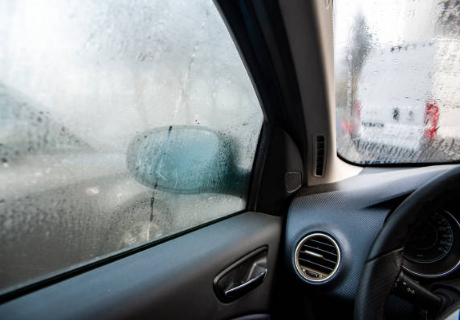Picture this: it’s a cold winter day and you’re driving home from work. You’ve turned up the heat to thaw your frozen toes, but your windshield is fogging. You start thinking, “Why is there so much moisture in my car?” and “How do I get rid of it?!” and this blog will explain why condensation is on your car’s windows, what that means, and how to get rid of it.
What Causes Condensation in a Car?
Condensation occurs when water vapor turns into liquid water – as opposed to evaporation. You might think that condensation is the reason why your soda can gets wet on a hot day. Condensation can also occur in the car, especially on windows and windshields. Here are the main reasons:

Outdoor Weather Conditions
Sometimes, condensation on a vehicle’s windshield or windows can be caused by the weather outside the vehicle. If the temperature outside the car is cooler than the inside of the car (as is the case in winter), the moisture inside the car can cause condensation on the windows.
Humidity in the Car
When you breathe in a car, a lot of humidity is created in the air. The extra moisture can accumulate on the windows and windshield in the form of condensation. This can also be caused by wet items left behind in the car, such as bags filled with sweaty gym gear or swimsuits that get wet during an early morning run.
The Seals Are Defective
There are rubber seals around vehicle openings, including windows, sunroofs, doors, and windshields. These seals offer a variety of benefits, including preventing unwanted air, liquids, and debris from entering your vehicle. They also help minimize drag when your vehicle is traveling at high speeds. So, if you’re wondering “why do my car windows keep steaming,” you might want to take a look at these seals.
Damaged seals can allow moisture from rain or snow to enter your car. They also don’t isolate vehicles well, which can lead to condensation buildup.
Problems with the Heater Core
This may sound strange, but a damaged heater core can cause condensation to appear in the car. When you turn on the heating, the heater core uses the heat of the engine coolant to blow hot air into the cab. A damaged heater core may cause coolant to leak into the car through the vents, creating condensation in the car. As you might imagine, this shouldn’t be something you shouldn’t be fixing. If you suspect that the heater core is damaged, contact a professional technician as soon as possible.

How to Eliminate Condensation in the Car?
To eliminate condensation in the car, you need to determine the cause through the elimination process.
1. Try adjusting the temperature.
If there is a significant difference between the outside temperature and the inside of the car, condensation may form. So, try adjusting the humidity level in your car.
First, turn off the recirculation function and turn on the air conditioner. This may bring dry air into the car, reducing humidity. You can then try turning up the temperature to bring in more dry air. If it still doesn’t work, open the window and drive for a few minutes to see if that helps.
2. Remove wet clothing.
Have you thrown your sweaty running shoes in the back seat and forgotten about them?How about cleaning up your muddy puppy with a damp towel after a frolic in the dog park?Check your vehicle for wet clothes and items that could bring extra humidity to your car.
3. Check the door and window seals for damage.
Some seals, such as those on windows and doors, are easy to inspect. Visually, you can look at the wet rubber seals on the windows and doors to look for cracks, tears, and breaks. Physically, you can touch these seals to make sure they don’t become brittle, cracked, or overly soft, as if they were melting.
4. Look for signs of damage to the heater core.
If none of these fixes help, you may be experiencing a heater core issue. Signs of heater core damage include:
- There was a sweet, almost syrupy smell in the car
- Your heating isn’t working well or isn’t working at all
- Condensation accumulates on the windshield and windows, leaving a greasy film
- When you turn on the heater, you can see mist or liquid spraying out of the vents
- You may see coolant leaking from behind the dashboard into the cabin
